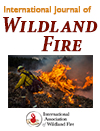
International Journal of Wildland Fire
Volume 33 Number 6 2024
Five models for the moisture content of fine dead fuels were evaluated using empirical datasets. Simple functions of the difference between air temperature and relative humidity were shown to perform as well as, if not better than exponential models based on vapour pressure deficit.
WF23120 Abstract | WF23120 Full Text | WF23120PDF (3.6 MB) | WF23120Supplementary Material (1.8 MB) Open Access Article
Global change is pushing fire activity and impact beyond known trajectories. We reviewed the literature to bring forward five themes of attention for governance systems. The initial framing was then applied to the case of Cyprus, to exemplify the potential and urgency for change in wildfire thinking and action globally.
WF23177 Abstract | WF23177 Full Text | WF23177PDF (4.2 MB) | WF23177Supplementary Material (33 KB) Open Access Article
Remote sensing is frequently used in fire ecology and management, but its applications for prescribed burning are not well established. We review studies that use remote sensing for prescribed burn research, finding that wildfire remote sensing approaches are not optimised for small, short-duration and low-severity burns typical of prescribed fire.
WF23130 Abstract | WF23130 Full Text | WF23130PDF (1.9 MB) | WF23130Supplementary Material (360 KB) Open Access Article
We propose a method to identify the climate window when prescribed burning in Tasmania, Australia is unlikely to lead to organic soil combustion, using observations of when organic soil fires occurred, and vegetation is dry enough to burn.
WF24061 Abstract | WF24061 Full Text | WF24061PDF (2.1 MB) | WF24061Supplementary Material (1.3 MB) Open Access Article
Reptile responses to fire are poorly understood in urban remnants. We examined reptile responses in the first 15 years post-fire and compared them to studies in contiguous vegetation. There were no long-term impacts of fire on reptiles after 3 years post-fire.
WF24033 Abstract | WF24033 Full Text | WF24033PDF (2 MB) | WF24033Supplementary Material (543 KB) Open Access Article
Fire regimes can have a significant bearing on terrestrial carbon stocks, with carbon markets potentially providing a mechanism to support land management activities. We quantify the effect of time-since-fire and prior fire interval on biomass carbon in the world’s largest extant Mediterranean-climate woodland, located in south-western Australia. Photographs by C. Gosper.
WF23159 Abstract | WF23159 Full Text | WF23159PDF (3.1 MB) | WF23159Supplementary Material (216 KB) Open Access Article





